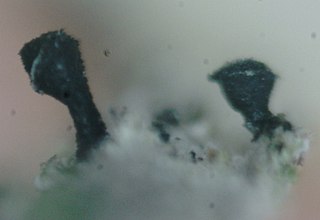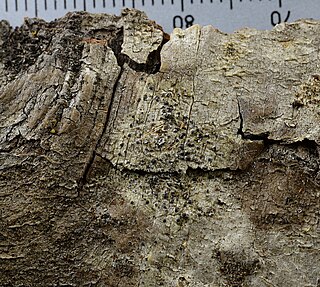
Pilophorus acicularis, commonly known as the nail lichen or the devil's matchstick lichen, is a species of matchstick lichen in the family Cladoniaceae.

Calicium abietinum, commonly known as fir pin or black stubble, is a crustose lichen that is found growing on trees throughout much of the world.
Calicium chlorosporum is a crustose lichen that is found growing on trees throughout much of the world.

Calicium glaucellum is a crustose lichen that is found growing on trees throughout much of the world. The species is similar to Calicium abietinum.
Pertusaria albineoides is a species of corticolous (bark-dwelling), crustose lichen in the family Pertusariaceae. Found on the Galápagos Islands, it was formally described as a new species in 2015 by Frank Bungartz, A.W.Archer, Alba Yánez-Ayabaca, and John Elix. The type specimen was collected on Alcedo Volcano at an altitude of 1,089 m (3,573 ft), where it was found growing on a partially shaded, rain- and wind-exposed trunk of Scalesia microcephala. The species epithet refers to the similarity to the species Pertusaria albinea, from which it differs by having thin-walled ellipsoid-shaped ascospores that are longer and narrower.
Pertusaria cerroazulensis is a species of corticolous (bark-dwelling), crustose lichen in the family Pertusariaceae. Found on the Galápagos Islands, it was formally described as a new species in 2015 by Frank Bungartz, Alan W. Archer, Alba Yánez-Ayabaca, and John Elix. The type specimen was collected from the Cerro Azul volcano at an altitude of 1,038 m (3,406 ft), where in a small, shaded woodland, it was growing on twigs of Psidium galapageium. The species epithet refers to the type locality.
Astrothelium nigrum is a species of corticolous (bark-dwelling) lichen in the family Trypetheliaceae. It is characterized by its conical black pseudostromata, which contrast sharply with the thallus. This lichen species has been found only in Brazil and is unique in its appearance, superficially resembling a Pyrenula species.

Fissurina insidiosa is a species of corticolous (bark-dwelling), script lichen in the family Graphidaceae. Found in the Southern Hemisphere, it has been recorded from mainland Australia, New Zealand, the Pacific region, the Caribbean, and India.
Caloplaca nothoholocarpa is a species of saxicolous (rock-dwelling), crustose lichen in the family Teloschistaceae. It is found in Chile.
Filsoniana ferdinandmuelleri is a species of saxicolous (rock-dwelling), crustose lichen in the family Teloschistaceae. It is found in Australia. The lichen has a squamulose (scaly) thallus, with a range of bright yellow to greenish-yellow and brownish-orange colours in its soredia and apothecia, respectively. The areoles of this lichen are varied in size, slightly raised from the thallus surface, and each carries one to four apothecia. The soralia are rounded or irregularly shaped, covering most of the thallus surface as a yellow to greenish-yellow mass. The apothecia have dark brownish-orange discs, surrounded by slightly paler yellow margins, with the spore-bearing asci containing typically eight brownish-golden ascospores.

Teloschistes capensis, commonly known as the Cape hair lichen, is a species of fruticose lichen in the family Teloschistaceae. It is endemic to the Atlantic coast in Namibia and South Africa.

Buellia oidalea is a species of crustose lichen found along the Pacific coast of North America, from Coos County, Oregon to Baja California Sur.
Buellia stellulata, commonly known as the disc lichen) is a species of crustose lichen that is widely distributed throughout the Northern Hemisphere.
Buellia bahiana is a crustose-type lichen species that frequently grows on the bark and wood of trees found in coastal and inland forest habitats. This lichen species exhibits a broad geographic distribution, being documented in various pantropical and subtropical regions around the world. Specific areas where Buellia bahiana has been recorded include parts of Australia, Africa, North America, Central America, South America, and several Pacific Island chains.

Mycoblastus sanguinarius, commonly known as the bloody heart lichen, is a widespread species of crustose lichen in the family Tephromelataceae. It is distinguished by its pale to dark grey thallus, which can appear very irregular and uneven, often with a thick, coarse, wart-like texture. The thallus may be continuous or somewhat cracked, with a prothallus that ranges from pale to dark grey. The apothecia are frequent, black, and become convex or hemispherical as they mature. These structures develop on a bright carmine-red thalline cushion, which is revealed when the thallus is damaged or worn. The lichen grows in temperate and montane forests across Asia, Europe, and North America. Usually found on tree bark, it has been recorded less frequently on decorticated wood and moss-covered rocks.
Placidiopsis hypothallina is a species of saxicolous (rock-dwelling) crustose lichen in the family Verrucariaceae, described as a new species in 2002. It is unique within its genus for its thallus primarily composed of a hyphal hypothallus resembling a subiculum found in some non-lichenised ascomycetes. It is found in Brazil and Taiwan.
Pyrenula albonigra is a species of corticolous (bark-dwelling), crustose lichen in the family Pyrenulaceae. Found in Brazil, this species is notable for its pale grey, somewhat glossy thallus that also covers the ascomata, except for a prominent black opening (ostiole). The ascospores are 3-septate, meaning they are divided into four sections, and measure 17–20 μm by 7–9 μm.
Pyrenula celaticarpa is a species of corticolous (bark-dwelling), crustose lichen in the family Pyrenulaceae. Found in Brazil, this species is notable for its deeply immersed ascomata with distinctive red ostioles (openings). The ascospores are 3-septate, meaning they are divided into four sections, and measure 21–24 μm by 10–11 μm.
Anisomeridium globosum is a species of corticolous (bark-dwelling), crustose lichen in the family Monoblastiaceae. This species is characterised by its greyish-green thallus and its almost globose (spherical) ascomata. The ascospores are 1-septate, meaning they are divided into two sections, and measure 8–10.5 μm by 4.5–6 μm. The septum is distinctly submedian, such that the lower cell is only about a quarter of the size of the upper cell.

Acrocordia cavata is a species of corticolous (bark-dwelling), crustose lichen in the family Monoblastiaceae. It was first formally described in 1814 by the Swedish lichenologist Erik Acharius, who classified it in the genus Verrucaria. The taxon was later proposed for inclusion in the genera Sphaeria, Amphisphaeria, and Arthopyrenia. Richard Harris reclassified it in the genus Acrocordia in 1974.








